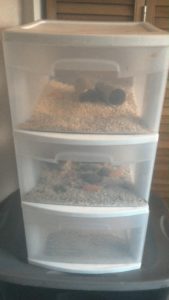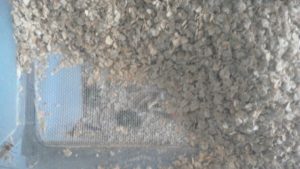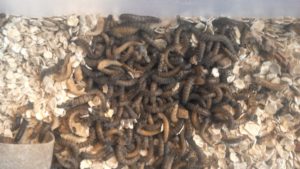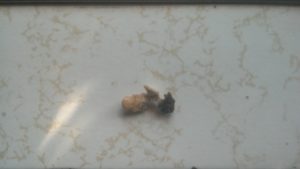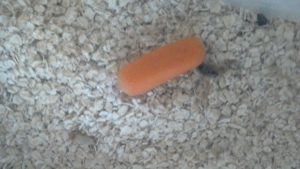Mealworms and Darkling Beetles
My chickens LOVE mealworms. I buy big bags full of them dried and throw a couple handfuls into their dinner bucket, along with a couple large kale leaves, another one of their favorites.
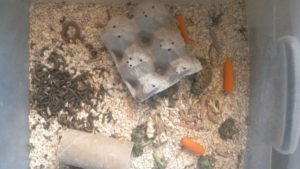 Mealworms are the larval stage of the Darkling Beetle, a flightless, thin, dark brown to black beetle found in dark, damp places full of organic matter. I had heard about people ordering beetles by the hundreds and raising their own mealworms, so when I came across several darkling beetles under a log I grabbed a plastic shoebox storage container, and began the journey of raising mealworms.
Mealworms are the larval stage of the Darkling Beetle, a flightless, thin, dark brown to black beetle found in dark, damp places full of organic matter. I had heard about people ordering beetles by the hundreds and raising their own mealworms, so when I came across several darkling beetles under a log I grabbed a plastic shoebox storage container, and began the journey of raising mealworms.
Beetles and mealworms are easy to keep. The most popular feed for them is oatmeal, cornmeal, and wheat bran, along with fruits and vegetables from which they get their moisture. Most people prefer to use carrots because they don’t mold, but I found they were happy with a variety of whatever I had on hand to throw in there. A word of caution here, some people can be allergic to mealworms, or more likely the frass (small dust from food, molted skin particles, and poop), so it’s best to keep them somewhere separate from the rest of the house if possible, but preferably with a temperature between 70-80 degrees for best growth rates.
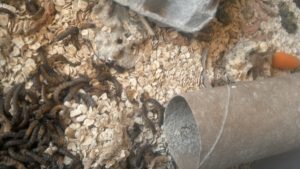 A couple of weeks later I grabbed my magnifying glass and dug through the oatmeal checking for babies. I had no idea they would be so tiny…nearly impossible to see when newly hatched! If you look closely, you can see a little one inside the paper tube. They’re much smaller when they first hatch.
A couple of weeks later I grabbed my magnifying glass and dug through the oatmeal checking for babies. I had no idea they would be so tiny…nearly impossible to see when newly hatched! If you look closely, you can see a little one inside the paper tube. They’re much smaller when they first hatch.
I now have them set up in a three-drawer suite. The adult beetles are in the top drawer, set up with a screen at the bottom for eggs and little babies to drop into the next drawer down, shown in the second picture. They’ll molt several times as they grow, before they enter the pupae stage.
In the first picture below you can see pupae and larvae mixed together. They like it dark, this group was under the egg carton. I try to keep larvae separated from adults, and pupae separated from larvae to prevent them from being eaten, like this one was in the second picture below. Third picture shows three newly emerged adult darkling beetles. The dark one along the top of the picture is already trying to bury itself in the oatmeal. By the carrot one is still working on emerging, and below the carrot is one that just emerged from the pupal phase. They are lighter colored at first, and darken within a few hours as their exoskeleton hardens.
Here’s my video of a darkling beetle emerging from it’s pupal cycle. If you’d like more info on farming mealworms, there are tons of videos on YouTube on the subject, both for feeding to animals and for human consumption. They’re supposed to be a really efficient source of protein to raise, but I think I’ll stick to feeding them to my chickens, although it may be less efficient, eggs are a complete source of protein, and something I am more accustomed to eating. 🙂
[amazon_link asins=’B074DT9XG4,B01MEEBLO1,B001KN12PI,B076352YVH’ template=’ProductGrid’ store=’ds’ marketplace=’US’ link_id=’7202417d-3290-11e8-bd32-dd5b59a1666a’]

